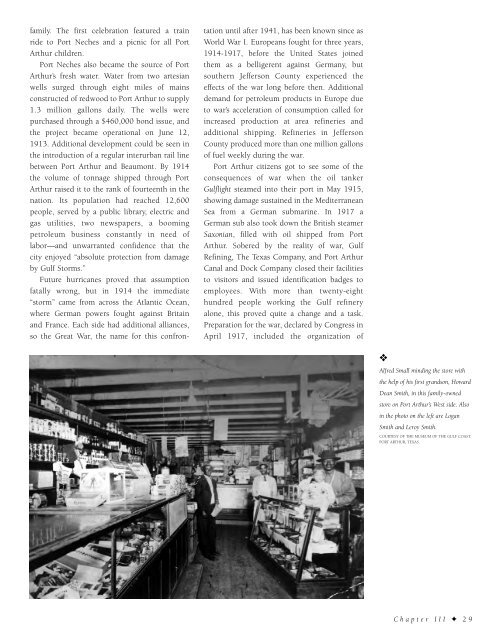Water Rails & Oil - Historic Mid & South Jefferson County
An illustrated history of the Mid and South Jefferson County area, paired with the histories of companies, families and organizations that make the region great.
An illustrated history of the Mid and South Jefferson County area, paired with the histories of companies, families and organizations that make the region great.
You also want an ePaper? Increase the reach of your titles
YUMPU automatically turns print PDFs into web optimized ePapers that Google loves.
family. The first celebration featured a train<br />
ride to Port Neches and a picnic for all Port<br />
Arthur children.<br />
Port Neches also became the source of Port<br />
Arthur’s fresh water. <strong>Water</strong> from two artesian<br />
wells surged through eight miles of mains<br />
constructed of redwood to Port Arthur to supply<br />
1.3 million gallons daily. The wells were<br />
purchased through a $460,000 bond issue, and<br />
the project became operational on June 12,<br />
1913. Additional development could be seen in<br />
the introduction of a regular interurban rail line<br />
between Port Arthur and Beaumont. By 1914<br />
the volume of tonnage shipped through Port<br />
Arthur raised it to the rank of fourteenth in the<br />
nation. Its population had reached 12,600<br />
people, served by a public library, electric and<br />
gas utilities, two newspapers, a booming<br />
petroleum business constantly in need of<br />
labor—and unwarranted confidence that the<br />
city enjoyed “absolute protection from damage<br />
by Gulf Storms.”<br />
Future hurricanes proved that assumption<br />
fatally wrong, but in 1914 the immediate<br />
“storm” came from across the Atlantic Ocean,<br />
where German powers fought against Britain<br />
and France. Each side had additional alliances,<br />
so the Great War, the name for this confrontation<br />
until after 1941, has been known since as<br />
World War I. Europeans fought for three years,<br />
1914-1917, before the United States joined<br />
them as a belligerent against Germany, but<br />
southern <strong>Jefferson</strong> <strong>County</strong> experienced the<br />
effects of the war long before then. Additional<br />
demand for petroleum products in Europe due<br />
to war’s acceleration of consumption called for<br />
increased production at area refineries and<br />
additional shipping. Refineries in <strong>Jefferson</strong><br />
<strong>County</strong> produced more than one million gallons<br />
of fuel weekly during the war.<br />
Port Arthur citizens got to see some of the<br />
consequences of war when the oil tanker<br />
Gulflight steamed into their port in May 1915,<br />
showing damage sustained in the Mediterranean<br />
Sea from a German submarine. In 1917 a<br />
German sub also took down the British steamer<br />
Saxonian, filled with oil shipped from Port<br />
Arthur. Sobered by the reality of war, Gulf<br />
Refining, The Texas Company, and Port Arthur<br />
Canal and Dock Company closed their facilities<br />
to visitors and issued identification badges to<br />
employees. With more than twenty-eight<br />
hundred people working the Gulf refinery<br />
alone, this proved quite a change and a task.<br />
Preparation for the war, declared by Congress in<br />
April 1917, included the organization of<br />
❖<br />
Alfred Small minding the store with<br />
the help of his first grandson, Howard<br />
Dean Smith, in this family-owned<br />
store on Port Arthur’s West side. Also<br />
in the photo on the left are Logan<br />
Smith and Leroy Smith.<br />
COURTESY OF THE MUSEUM OF THE GULF COAST,<br />
PORT ARTHUR, TEXAS.<br />
Chapter III ✦ 29
















